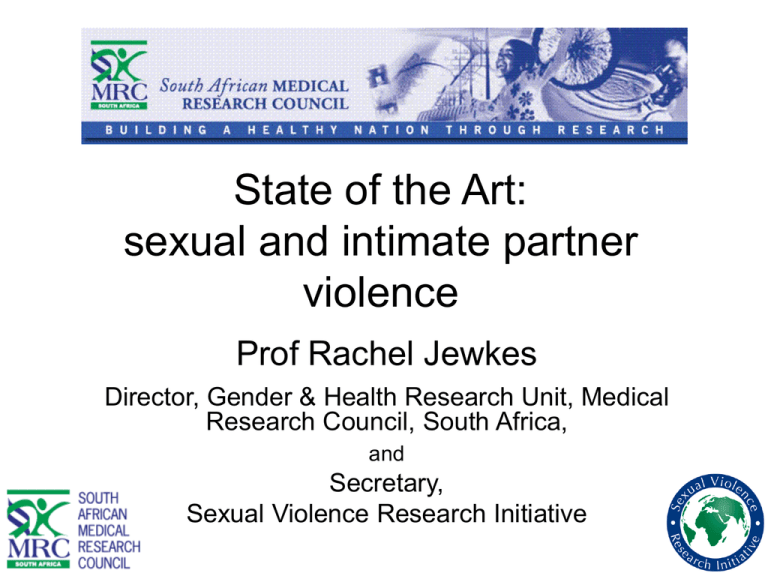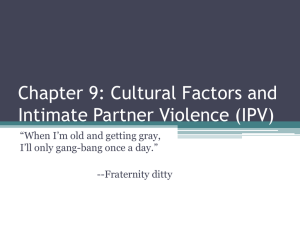
State of the Art:
sexual and intimate partner
violence
Prof Rachel Jewkes
Director, Gender & Health Research Unit, Medical
Research Council, South Africa,
and
Secretary,
Sexual Violence Research Initiative
Introduction
• Sexual violence and intimate partner
violence are fundamental violations of
victim human rights – the rights to dignity,
bodily integrity, life and health
• Their health impact is magnified by their
role as risk factors for other major
diseases, notably HIV in women
• Our goal is prevention of sexual and
intimate partner violence
What does sexual and IPV encompass?
Intimate partner violence
Sexual abuse of children
Rape/ sexual violence against adults
Primary prevention
• Strategies must be tailored around evidence of
who perpetrates and what is driving SV/IPV
perpetration
• Based on interventions with a sound theoretical
basis from which one can realistically anticipate
impact on behaviour change
• Targeting perpetration, tackling underlying
causes
• First step: research to understand the problem:
– Research on victimisation and on perpetration
Prevalence of victimisation:
• Has been the predominant focus of
research globally on GBV, notably the
WHO multi-country study found:
– 1 - 21% had experienced sexual abuse < age
15 years
– 15 - 71% had experienced physical or sexual
intimate partner violence (IPV)
– 0.3 - 11.5% had experienced sexual violence
by a non-partner when > 15 years
Risk factors for sexual violence victimisation:
•
•
•
•
•
Young age
Poverty
Physical disability
Dysfunctional homes
Mental vulnerability: learning difficulties,
depression, PTSD etc
• Prior victimisation
• Substance abuse
• These are ALL vulnerability factors – they do not
CAUSE sexual violence
Prevalence of rape perpetration
30
25
20
South Africa
India
Croatia
% 15
10
5
0
All rape
SIPV
Gang
rape
Past 12m stranger
rape
Prevalence of physical & sexual intimate partner violence in
ever partnered South African & Indian men (and all
Croatians)
50
45
40
35
30
South Africa
India
Croatia *
% 25
20
15
10
5
0
Physical IPV
Sexual IPV
Distribution of victim numbers among men who
have raped
70
60
50
40
South Africa
India
Croatia
%
30
20
10
0
1
2-3
4-5
6-10
11+
SV/IPV are important adolescent health problems
• Men who will perpetrate normally do so for the
first time during adolescence:
– In South Africa, 73% of adult men who have raped
have done so for the first time by the age of 20 years
– In the US, most college (adult) rape perpetrators are
first sexually aggressive when at school (White & Hall Smith
2004, Abbey & McAuslan 2004)
• Victims normally first experience violence as
adolescents:
– WHO found 3-24% force first sex
– IPV is common in dating relationships
Motivations for rape, South African men
80
Girl<15 yrs
70
Girlfriend
60
Non-partner
50
Gang rape
40
30
20
10
0
al
u
x
e
S
m
e
l
t
ti
n
e
t
en
er
g
An
om
d
re
o
B
A
l
o
h
o
c
l
n
u
F
Childhood environment & trauma
Raped by a man
Mother's education: none
some schooling
completed school or higher
Rape
%
17.2%
16.2%
70.1%
13.8%
Never raped
%
6.3%
25.4%
68.0%
6.6%
10.53
10.91
<0.0001
11.18
45.6%
72.7%
12.16
38.0%
65.2%
<0.0001
0.012
0.006
67.5%
21.09
49.5%
18.48
<0.0001
<0.0001
p value
<0.0001
<0.0001
Childhood experiences
Perceptions of maternal kindness
(mean score)
Perceptions of paternal kindness
(mean score)
Mother never or rarely at home
Father never or rarely at home
Was teased and harassed as a
child
Childhood trauma scale
Rape
%
Attitudes
Gender equitable men
scale
Adversarial sexual beliefs
score
Hostility towards women
score
Rape myth score
Psychological
measures
Life circumstances now
less good than peers
Machievellian
egocentricity & blame
externalisation (mean)
Empathy (mean)
Never raped
%
p value
22.36
23.81
<0.0001
14.14
14.79
0.018
4.39
3.96
0.023
9.89
9.42
0.013
28.1%
16.9%
<0.0001
33.61
0.45
28.24
0.55
<0.0001
0.001
Rape
Never
raped
%
%
p value
Alcohol
21.4% 35.1% <0.0001
moderate 43.3% 44.3%
high 35.3% 20.7%
Drug use in the
past year
56.3% 31.6% <0.0001
Gang
membership
22.2%
7.0% <0.0001
Relations with women
> 20 sexual
partners
52.8% 25.3% <0.0001
Any transactional
sex
Physical IPV:
never
once
more than 1 time
or type
78.5%
58.8%
<0.0001
32.1%
15.9%
67.4%
12.2%
<0.0001
52.0%
20.3%
Violent and anti-social behaviours
Rape Never raped
%
%
p value
School bullying
score
12.29
9.90
<0.0001
Stolen something or
had stolden goods:
Never
22.9%
50.4% <0.0001
1-2 occasions 19.0%
25.2%
3 or more 58.1%
24.4%
Ever in possession
of an illegal gun
24.1%
6.1%
<0.0001
Has a licenced
firearm
7.4%
5.6%
0.219
Has a weapon other
than a licenced
firearm
31.3%
16.1% <0.0001
Rape of a man
9.5%
0.5%
<0.0001
Arrested for another
crime
29.0%
20.8%
0.001
Multivariable model of factors associated with raping
adjusted)
p value
0.012
0.002
some schooling
OR
1.04
2.18
1.00
1.96
completed school or higher
4.24
<0.0001
Past year drug use
Ever a gang member
0.97
1.66
1.03
1.50
1.88
0.024
0.008
0.001
0.013
0.007
>20 sexual partners
1.82
<0.0001
Ever had transactional sex
1.53
0.029
Physical IPV perpetration: never
once
1.00
1.77
0.015
more than 1 time or type
2.82
<0.0001
Childhood trauma scale
Raped by a man
Mother's education: none
Gender equitable attitudes scale
Life circumstances less good than peers
Anti-social personality/blame externalisation
0.003
(age
Model of factors associated with having raped in the previous 12
months, South African men (18-49 years)
(adjusted for age and stratum)
OR
95% CI
Childhood trauma scale
1.04
1.00
1.09
0.04
Machievellian
egocentricity & blame
externalisation
1.06
1.03
1.09
<0.0001
1.97
1.02
3.82
0.044
once
1.00
2.53
1.10
5.82
0.029
more than 1 time or type
3.36
1.75
6.48
<0.0001
Raped by a man
Physical IPV
perpetration:
never
p value
What are the key areas for intervention to
prevent sexual violence?
• Structural factors: poverty, education,
• Gender inequality:
– Essential differential valuation of men &
women (esp. seen in sanctions/impunity)
– Generates expectations of gendered
powerfulness, permits exploration of power
– Legitimisation of male control of women and
the use of violence against women
• Childhood: exposure to adversity, trauma
What about intimate partner
violence perpetration?
• Many of the risk factors are the same
• Notable differences:
– Women are placed at risk by their own
acquiescence to patriarchy (need to promote
empowered femininities)
– Women’s material/political empowerment
generally and specifically is protective
– Relationship discord & poor conflict skills are
risk factors
Translating this into an intervention
agenda:
• Need intervention at all levels – societal,
community, family and individual
• Need to combine actions:
– those aimed at reducing perpetration
– those protecting victims
– responses for victims
– those aimed at removing impunity
• Need a long term view of change
Need evidence of effectiveness
• What works in sexual and IPV prevention?
(WHO review 2010)
– High income countries:
• The only interventions that have been evaluated in
RCTs and shown effective are school-based
programmes aimed at reducing perpetration –
examples Safe Dates and Fourth R (USA &
Canada)
– Middle and low income countries:
• Stepping Stones – reduced perpetration of IPV
• IMAGES – microfinance, community action,
reduced women’s victimisation
• Neither study has yet been replicated
Evidence (not yet from RCTs) to support:
• Interventions with abuse-exposed children to
prevent IPV
• School programmes to raise awareness of CSA
risk
• Alcohol use reduction interventions to prevent
IPV
• Gender norms interventions with men and boys
• we have also learnt some interventions do NOT
work (see WHO, 2010)
• Secondary prevention
–Responses to assist victim/
survivors of rape/sexual violence
and IPV
Responses to rape in the health sector
• The tools are available for the health sector:
Model policies
Management guidelines
e.g. FIGO’s
Training curriculum e.g. South African National
Department of Health’s
• Comprehensive package of post-rape care is
needed
• Tailoring of care depending on whether the care
is started soon after the (last) event or whether
there has been a delay (months or years)
• Tailored for both adults and children
State of the Art post-rape care:
• Comprehensive
• Survivor centred
• Provided by trained health care providers with
clear protocols/guidelines
• Integrates adult and child care (except in high
resource settings)
• Integrates psychological support/ mental health
care for survivors
• Tailored to maximise medication course
completion – especially PEP – e.g. using
tenofovir/FTC regimen; progestogen-only
emergency contraception
• Abortion
Health sector responses to IPV
• Evidence that asking women about IPV / SV
experience is critical and offering simple
messages and practical assistance is valuable;
documentation may be valuable
• Challenge – is implementation
– This must include introducing gender-based violence
into undergraduate / basic training for nurses and
doctors
– In-service training may be best but its is a greater
challenge to resource and implement and so there
are challenges for coverage
Secondary prevention responses
must be multi-sectoral:
• Include:
– Health sector
– Social workers/ designated child protection
agencies
– Police
– Prosecution service / courts
Good post-rape care has to be provided
within a human-rights framework
• Survivor-centred comprehensive post-rape care
requires changing the ethos, policies and
practices of social work, police and criminal
justice system
• Confronting gender inequitable value systems
upon which their policies and operations are
based is essential
• Analysing the nature of the challenge and
developing strategies for change which
appropriately balance deployment of evidence
and engagement with underlying politics and
values is critical
Conclusions
• Essential that we keep our eyes on the prize:
prevention sexual violence and IPV
• We need:
– national strategies that are tailored around a local
understanding of the problem
– to implement what works and theoretically-informed
best practice
– to escalate the intervention research
– to develop services for victims in tandem with rolling
out prevention interventions
• High level political support globally, nationally
and within communities is essential
Authors from the South African Study & IMAGES
• South African study team: Rachel Jewkes, Yandisa
Sikweyiya, Robert Morrell, Kristin Dunkle
• Funded by: the UK Department For International
Development (DFID), and grant was managed by their
local partner Human Life Sciences Partnership (HLSP)
• IMAGES Principal Investigators : Gary Barker, Meg
Greene, ICRW, Washington
• Croatia data: Natasa Bijelic, C E S I - Centar za
edukaciju, savjetovanje i istrazivanje, Zagreb, Croatia
• India data: Ravi Verma, Ajay Singh, Gary Barker, ICRW,
Delhi
• IMAGES Study: the project overall and India site funded
by the MacArthur Foundation, Ford Foundation, an
anonymous donor, and the Norwegian Ministry of
Foreign Affairs






